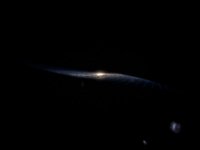You gotta be fast to keep up with this thread:

I have investigated the pentagonal symmetry of the Starfish. Interesting creatures, though possibly dull as dinner companions.
They evolve embryonically from creatures of bilateral symmetry. What we are seeing here is 4 legs and a tail. They then tuck their heads down underneath.
The bright colours signal "Poison: Do not Eat" to savvy predators. But certain folks eat them anyway. 😱
I have investigated the pentagonal symmetry of the Starfish. Interesting creatures, though possibly dull as dinner companions.
They evolve embryonically from creatures of bilateral symmetry. What we are seeing here is 4 legs and a tail. They then tuck their heads down underneath.
The bright colours signal "Poison: Do not Eat" to savvy predators. But certain folks eat them anyway. 😱
Nothing like a nice bowl of starfish soup!But certain folks eat them anyway. 😱
Attachments
I always look for the "Takeaway" in these issues.
I certainly wouldn't fancy Starfish Soup myself:

Just looks a bit creepy and crunchy. 😱
I have to be extremely careful what I say here, but the Chinese are famous for eating almost anything. IMO, it's got us into a lot of trouble. Especially with the current Covid-19 Crisis.
AFAIK, old China was a pretty lean old place, so people took their chances. But really, things like Bats just don't appeal to me as Dinner,
I certainly wouldn't fancy Starfish Soup myself:
Just looks a bit creepy and crunchy. 😱
I have to be extremely careful what I say here, but the Chinese are famous for eating almost anything. IMO, it's got us into a lot of trouble. Especially with the current Covid-19 Crisis.
AFAIK, old China was a pretty lean old place, so people took their chances. But really, things like Bats just don't appeal to me as Dinner,
Last edited:
OK, back on-topic.
Women have been a bit weak historically on Maths and Physics. We've really only had Fraulein Emmy Noether, Madamoiselle Sophie Germain and Madame Marie Curie in this field. Reason's abound, mostly because we men, with the possible exception of luminaries like Carl Friedrich Gauss and David Hilbert, have kept the whole thing a Boy's Club, IMO. 😱
I like her subject, and I like her independent approach, and Keith Richards look, and mixed-martial arts hobby. Canadian Miss Cohl Furey is into 8 dimensional octonions at Cambridge: Quanta Magazine
Simple enough to understand, complex enough to explain things like three generations of Quarks. I think she is onto something. 😎
Women have been a bit weak historically on Maths and Physics. We've really only had Fraulein Emmy Noether, Madamoiselle Sophie Germain and Madame Marie Curie in this field. Reason's abound, mostly because we men, with the possible exception of luminaries like Carl Friedrich Gauss and David Hilbert, have kept the whole thing a Boy's Club, IMO. 😱
I like her subject, and I like her independent approach, and Keith Richards look, and mixed-martial arts hobby. Canadian Miss Cohl Furey is into 8 dimensional octonions at Cambridge: Quanta Magazine
Simple enough to understand, complex enough to explain things like three generations of Quarks. I think she is onto something. 😎
I should probably quit while I am ahead. 🙂
But, IMO, William Hamilton was a man ahead of his time.
He got his Quaternions working just by giving up on the idea of Commutativity. The idea that AxB does NOT equal BxA.
This was 1843. He was hugely reviled in favour of a dubious theory called "Vectors" and angles.
Roll on 62 years, and Albert Einstein invented Quantum Theory in 1905. In which AxB does NOT equal BxA.
Game, Set and Match to Hamilton, IMO. Sod the "Vectors" and Angles. 😀
But, IMO, William Hamilton was a man ahead of his time.
He got his Quaternions working just by giving up on the idea of Commutativity. The idea that AxB does NOT equal BxA.
This was 1843. He was hugely reviled in favour of a dubious theory called "Vectors" and angles.
Roll on 62 years, and Albert Einstein invented Quantum Theory in 1905. In which AxB does NOT equal BxA.
Game, Set and Match to Hamilton, IMO. Sod the "Vectors" and Angles. 😀
The Milky Way galaxy is warped! (See attached visualisation.)
Earlier, we discussed an impending galactic collision.
Recently, focus has been placed on a collision thought to have already taken place between our galaxy and its near neighbour, the dwarf galaxy Sagittarius.
The warping of the galactic disc has been known about for decades, but new data on star speeds obtained from the Gaia spacecraft supports the hypothesis that a galactic collision is its cause.
According to the data, the warp would complete one rotation around the centre of the Milky Way in about 600 million years. (By comparison, the sun makes one orbit around the galactic centre in about 200 million years.)
Earlier, we discussed an impending galactic collision.
Recently, focus has been placed on a collision thought to have already taken place between our galaxy and its near neighbour, the dwarf galaxy Sagittarius.
The warping of the galactic disc has been known about for decades, but new data on star speeds obtained from the Gaia spacecraft supports the hypothesis that a galactic collision is its cause.
According to the data, the warp would complete one rotation around the centre of the Milky Way in about 600 million years. (By comparison, the sun makes one orbit around the galactic centre in about 200 million years.)
Attachments
Another interesting fact I saw today was that recent research suggests the MY is actually more massive than Andromeda and that’s down to a greater amount of dark matter even though Andromeda possibly has twice as many stars as the MY.
That discovery is also courtesy of the influx of new data being supplied by the European Space Agency's Gaia spacecraft.
"By combining data from the ESA's Gaia space probe and data from the Hubble space telescope astronomers were able to determine that the mass of the Milky Way is 1.5 trillion solar masses. The mass of Andromeda, on the other hand, is roughly 800 billion solar masses, according to current estimates."
"By combining data from the ESA's Gaia space probe and data from the Hubble space telescope astronomers were able to determine that the mass of the Milky Way is 1.5 trillion solar masses. The mass of Andromeda, on the other hand, is roughly 800 billion solar masses, according to current estimates."
That's the data I saw as well. If that's the case, the MY is truly massive and will be well within the top 10 most massive galaxies we know about. Of course the diameter of others may be larger, but we can get a pretty good idea of their mass from the difference in angular velocity between the central and outer regions.
😀
Another interesting fact is that it is very, very old - formed 300 MY after the BB.
Age estimates put it at 13.5 BY. Andromeda at c. 10 BY.
Another interesting fact is that it is very, very old - formed 300 MY after the BB.
Age estimates put it at 13.5 BY. Andromeda at c. 10 BY.
Now we're delving into the field of Galactic-archaeology!
Measuring the frequencies of oscillation of ''star-quakes' allows us to look back in time and discern the period in the Universe's history when the Milky Way formed; a practice known as Galactic-archaeology.
Apparently, the stars in our galaxy's 'thick disc' are older than in its 'thin disc'.
Star-quake vibrations lead to new estimate for Milky Way age | EurekAlert! Science News
Measuring the frequencies of oscillation of ''star-quakes' allows us to look back in time and discern the period in the Universe's history when the Milky Way formed; a practice known as Galactic-archaeology.
Apparently, the stars in our galaxy's 'thick disc' are older than in its 'thin disc'.
Star-quake vibrations lead to new estimate for Milky Way age | EurekAlert! Science News
Attachments
I linked to that article from a previous one which did give the age.
Data from the Kepler mission was used to revise the official estimate of the age of the Milky Way's thick disk to around 10 billion years old. (The thick disc contains about 20% of the galaxy's stars.)
It is also stated that the formation of the galaxy occurred over 13 billion years ago, in accordance with your post.
I guess the basic structure of the galaxy formed before the first stars burst into light.
Data from the Kepler mission was used to revise the official estimate of the age of the Milky Way's thick disk to around 10 billion years old. (The thick disc contains about 20% of the galaxy's stars.)
It is also stated that the formation of the galaxy occurred over 13 billion years ago, in accordance with your post.
I guess the basic structure of the galaxy formed before the first stars burst into light.
Galu said:I guess the basic structure of the galaxy formed before the first stars burst into light.
Let us do a little thought experiment.
When intergalatic gases condense into localised unignited gases, the condensed gases continue to get denser until pressure and heat at their centres, is sufficient to ignite hydrogen atoms into fusion. This means, star formation is more probable to be a continuous phenomenon.
Astronomers aren't certain exactly how galaxies formed.
Some think that gravity pulled dust and gas together to form individual stars, and those stars drew closer together into collections that ultimately became galaxies.
Others think that the mass of what would become galaxies drew together before the stars within them were created.
Recent work on the role of dark matter in the early Universe has led to the hierarchical or bottom-up model of galaxy formation gaining wide acceptance.
The Formation of Galaxies
Some think that gravity pulled dust and gas together to form individual stars, and those stars drew closer together into collections that ultimately became galaxies.
Others think that the mass of what would become galaxies drew together before the stars within them were created.
Recent work on the role of dark matter in the early Universe has led to the hierarchical or bottom-up model of galaxy formation gaining wide acceptance.
The Formation of Galaxies
Attachments
Yes - that's my understanding of galaxy formation as well. There are a few galaxies out there that are circa 500 million years old - I guess some of those from the Hubble deep field would be candidates because if I understood the description of the photo, the most distant ones were from >13 billion light years ago (very blue if the Doppler effect is taken into account so full of hot young stars) and the BB took place 13.8 BLY BP.
- Status
- Not open for further replies.
- Home
- Member Areas
- The Lounge
- What is the Universe expanding into..




